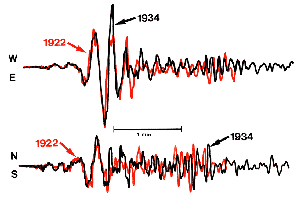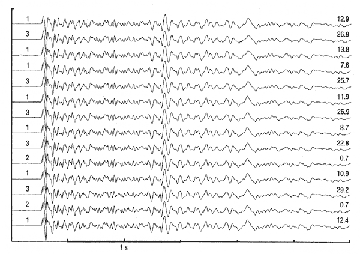
Do earthquakes occur completely randomly, or do they have a pattern that tends to repeat? If they're random, there's no hope for earthquake prediction. But as we saw in the earthquake history, regular repetitions of the same rupture event, called a "characteristic earthquake" may be occurring at Parkfield.
Indeed, this repetition was part of the basis for developing the Parkfield experiment. Figure 1 shows seismograms from two of the Parkfield earthquakes, both recorded in Berkeley, California. Again, the similarity of the first few cycles of the P and S waves means that these events ruptured the same part of the fault.
Adding to the sense of repetition, similar-size foreshocks occurred 17 minutes before both the 1934 and 1966 Parkfield earthquakes. The foreshocks produced nearly identical Wood-Anderson seismograms near Berkeley California.
The repeating rupture of a single section of a fault is conceived in physical models as a "stuck patch" on the fault's surface, around which strain energy builds up. When the patch ruptures, the strain is released and the loading process begins again. If the loading rate (plate motion) is constant, the timing of the earthquakes would be regular.
Apparent repetition on a smaller scale
Cole and Ellsworth (1995) have extended this observation to show that almost all M>4 earthquakes near Parkfield can be grouped into classes, each characterized by a distinctive seismogram and presumably repeatedly rupturing the same fault patch despite the occurrence of two M 6 earthquakes. The 1992 and November, 1993 events fit the formal criteria for potential Parkfield foreshocks (see status) and prompted public advisories of heightened probability of an M 6 earthquake. The connection of these events to the characteristic earthquakes at Parkfield is suggested by the fact that waveforms from the November, 1993 event were identical to those from a foreshock three days before the 1966 Parkfield mainshock. However, none of the earthquakes in Table 1 appears to be a repeat of the "17-minute" foreshocks.
| Date | Latitude | Longitude | Depth (km) | Magnitude (coda) |
|---|---|---|---|---|
| 1992/10/20 | 35.9285°N | 120.4728°W | 10.21 | 4.3 |
| 1993/04/04 | 35.9413°N | 120.4925°W | 7.65 | 4.2 |
| 1993/11/14 | 35.9527°N | 120.4968°W | 11.70 | 4.6 |
| 1994/12/20 | 35.9175°N | 120.4643°W | 9.10 | 4.7 |
Earthquake repetition on a "micro" scale
Since 1990, the high resolution seismic network at Parkfield (HRSN) has recorded earthquakes as small as M=0 on this stretch of the fault. Nadeau et al. (1994) showed that about half of the events (0.2 < Mw < 1.3) occur in about 300 distinct spatial clusters and have highly similar waveforms (Figure 2). Within clusters, relative locations based on wave form cross-correlation are accurate to within 5 m (Nadeau, 1997). Many of these clusters have characteristic recurrence times that appear to scale with the magnitude of the repeating events, supporting a simple model of stick slip on a stuck patch. Variations in the characteristic recurrence time were tentatively interpreted as indicating variations in slip rate on the fault.

Rubin et al. (1999) and Waldhauser et al. (1999) determined that these clusters are largely confined to distinct, nearly-horizontal "streaks" on the fault surface. The underlying cause of this structural organization on the fault surface remains to be determined.
These repeating microearthquakes also present an enigma. The simple model of a stuck patch fails to explain the occurrence rate of the smallest events. The time intervals between their recurrences are far too long (Nadeau and Johnson, 1998). Several models have been advanced to explain the mechanics of these repeating microearthquakes. We hope to test them directly by drilling into the rupture zone of one of these events as part of the National Science Foundation's EarthScope initiative.
Other interpretations of the data include Tullis (1999), who suggests that the micro-earthquake clusters may represent lithologically distinct sites that have velocity-weakening frictional behavior. Boatwright and Cocco (1996) suggest that a mix of velocity-weakening and velocity-strengthing behavior may occur where the fault creeps macroscopically while producing small earthquakes.
The picture emerging from these studies is that, at least on the Parkfield section of the San Andreas fault, earthquakes tend to occur as repeated ruptures of fixed patches of the fault, in approximate accordance with simple stick slip models, over a wide range physical sizes.
 Jump to Navigation
Jump to Navigation